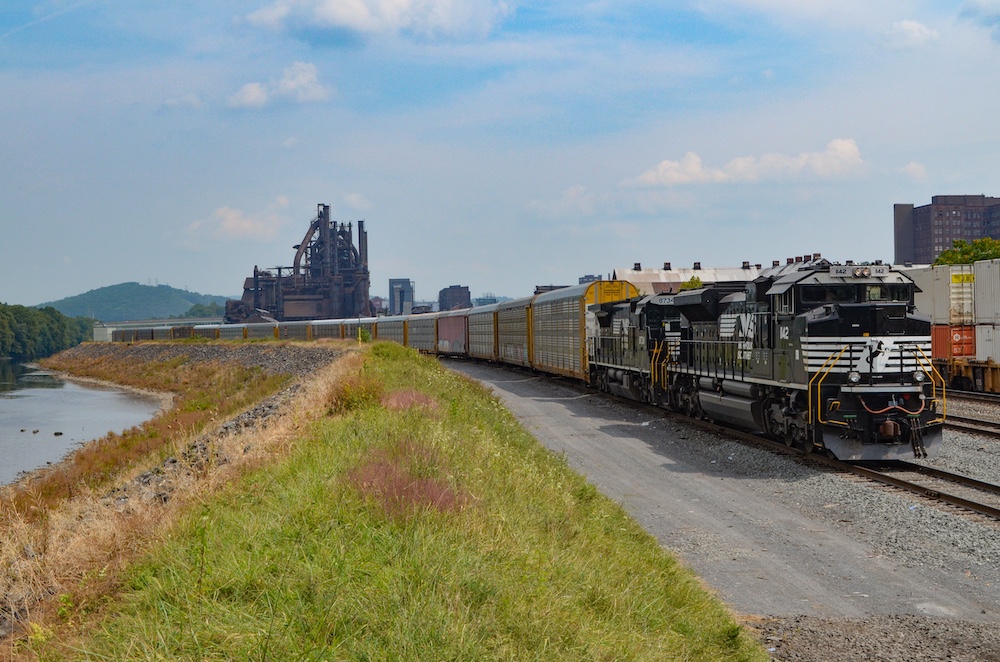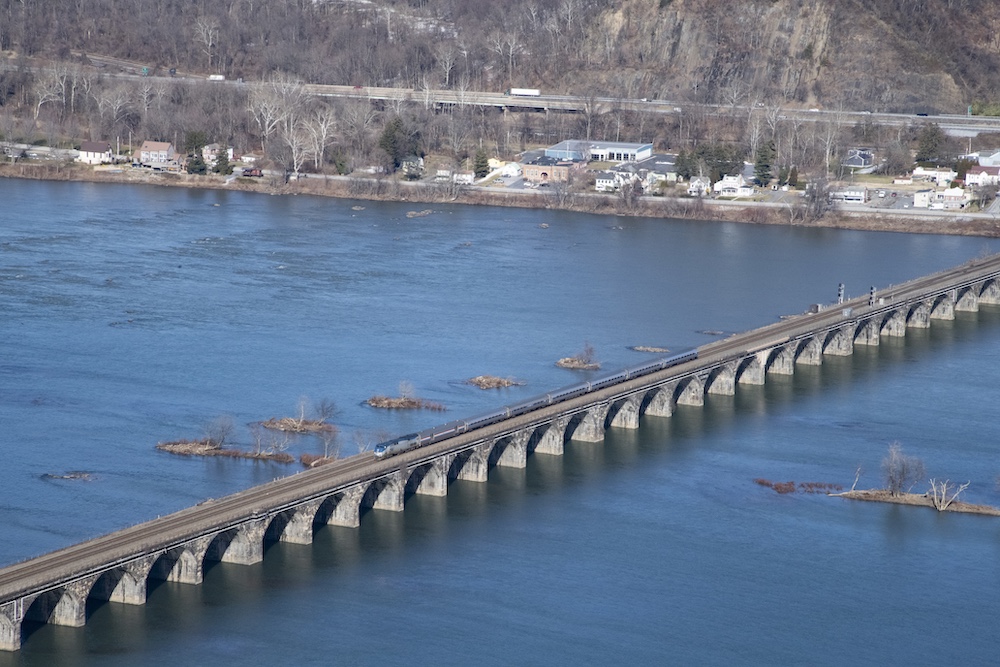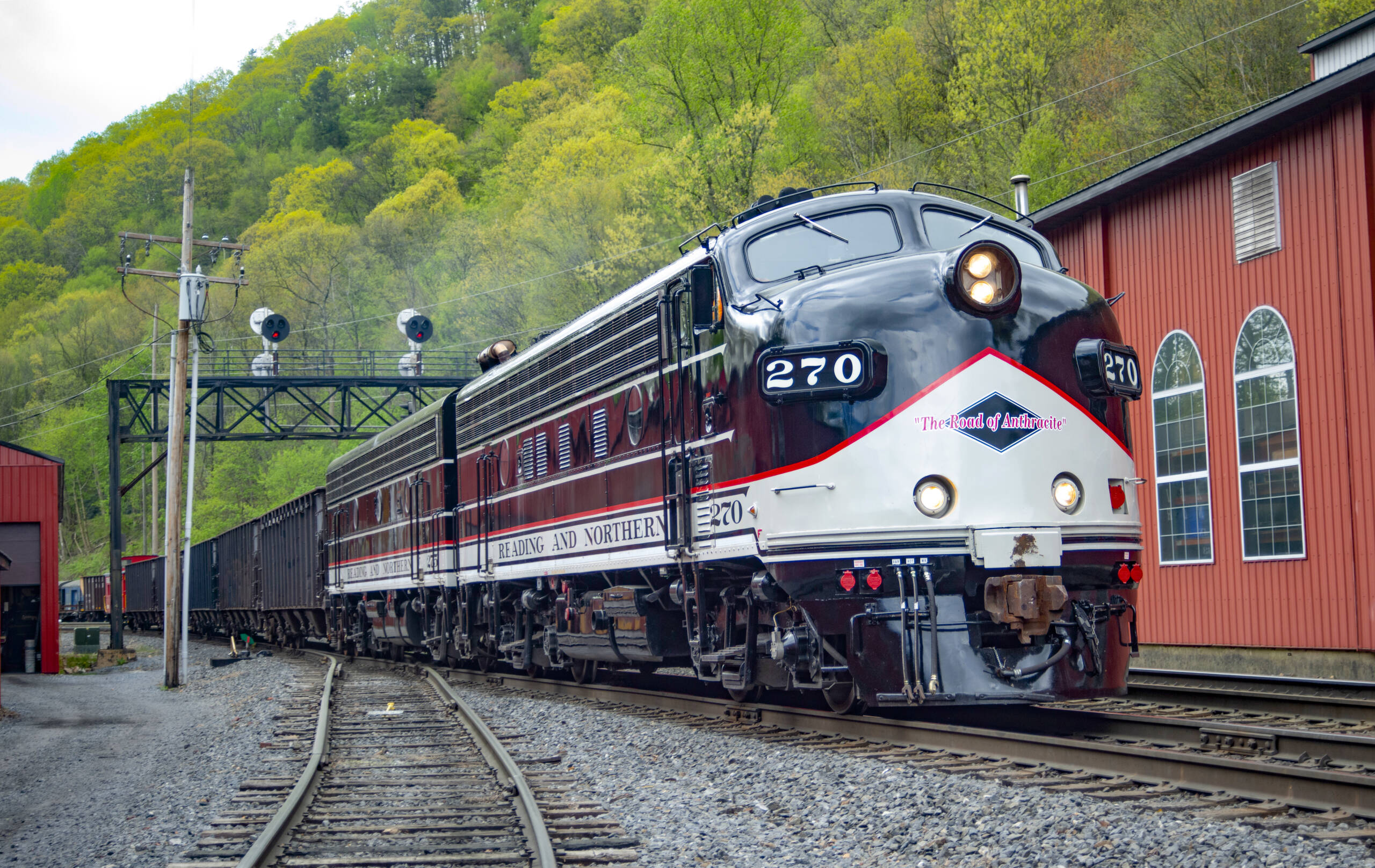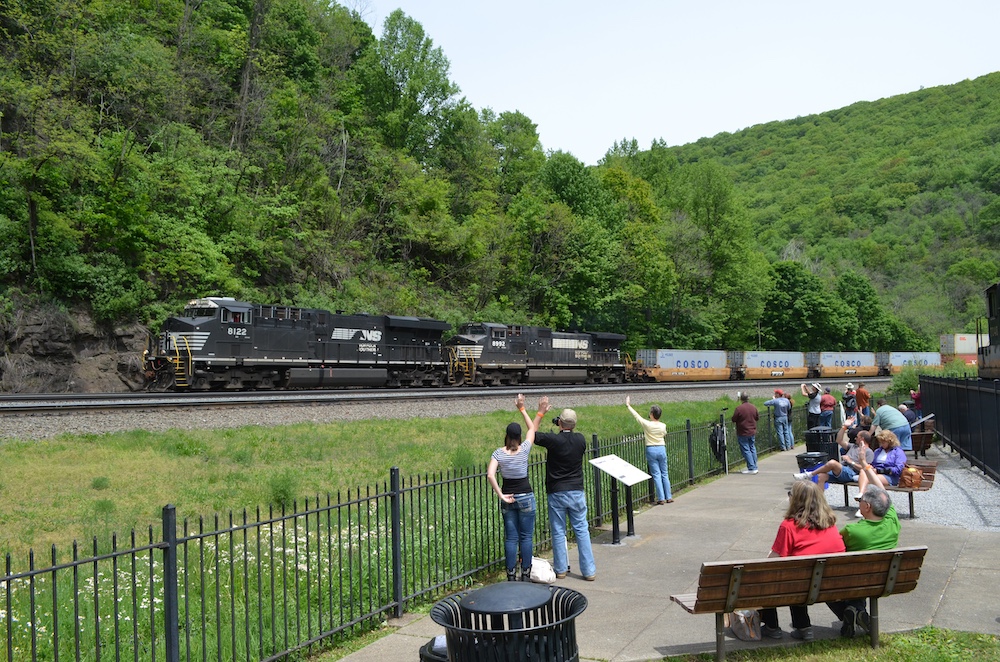Pennsylvania’s U.S. 22

It takes less than 6 hours to drive across Pennsylvania using Interstate 80 (boring) or the Pennsylvania Turnpike (expensive and boring). Instead, drive through Pennsylvania on U.S. Route 22 for a plethora of really interesting railroad sites and plenty of trains. Even on a multi-day trip there is almost too much to see — hard choices are ahead!
U.S. 22 runs from Cincinnati to Newark, N.J., and generally follows the former Pennsylvania Railroad and Reading mainlines across Pennsylvania. U.S. 22’s railroad interest comes from the scope and variety of railroad attractions along the way — like a horizontal Christmas tree, with the railfan attractions as ornaments.
Since Pittsburgh has enough rail attractions for its own article, the western tip of this article’s tree is the steel-hauling Union Railroad in the city’s eastern suburbs. Soon after Business U.S. 22 separates from the Parkway East (I-376), it passes over the Union and the line’s shops are down below. A quick left past the “Welcome to Monroeville sign” and through the Sam’s Club parking lot is the easiest way down. The shops are off-limits, but adjacent Thompson Run Road yields views of both the diesel-era shop building and 15-stall roundhouse and turntable.
For the next 30 miles, Route 22 splits the difference between Norfolk Southern’s former PRR main line to the south and NS’ low-grade Conemaugh Line to the north. U.S. 22 crosses above the Conemaugh Line at Blairsville, and a right turn takes you to the 1893 depot and a remaining spur of the former Pennsy Indiana (Pa.) branch.
Continue on 22 for 13 more miles until you turn on Pennsylvania state route 56 for Johnstown. Along the way at Seward, the road crosses under one track of the NS Pittsburgh (main) Line, goes over the Conemaugh River and then over the other two tracks of the Pittsburgh Line.
A rail historian’s bounty
Although Johnstown shows the scars from the steel industry’s demise and three devastating floods, the city is a rail historian’s bounty. Downtown’s Amtrak station is the most substantial PRR station remaining between Harrisburg and Pittsburgh and is only two blocks away from the Johnstown Flood Museum. You may get lucky and find the former Conemaugh & Black Lick Railroad (now operated by Lehigh Valley Rail Management) running on a weekday morning or activity on CSX’s S&C Subdivision, which branches off CSX’s main line 40 miles south in Rockwood, Pa. Johnstown’s Inclined Plane, dating from 1891, is out of service for renovations but provides worthwhile views when operating.
Johnstown is the foot of the Pennsylvania Railroad’s assault on the Alleghenies. The west slope doesn’t have Horseshoe Curve, but the 25-mile grade is spectacular in its own right. Distributed power has reduced but not eliminated the need for helpers over the Alleghenies and the helpers heaviest use is between Johnstown and Altoona. From Johnstown, continue eastward on state route 56, then get on U.S. 219 north.
This temporarily takes us away from the Norfolk Southern main line — unfortunately the sights along the railroad (including bypassed Staple Bend Tunnel, the first rail tunnel in the United States) aren’t easily accessible by car. Our route rejoins the Pittsburgh Line in South Fork, worthwhile for the nearby Johnstown Flood Memorial or to look for a South Fork Secondary coal train at the small NS yard.
Starting in South Fork, PA 53 plays tag with the tracks until the top of the hill at Cresson. Cassandra’s railroad overlook or “Iron Bridge” is worth a short detour — this now traffic-free bridge over the tracks is a great place to relax and watch the railroad parade. This, the busiest section of NS’ Pittsburgh Line, often hosts more than 50 train movements per day.
A hidden gem
Cresson marks the junction with R.J. Corman’s central Pennsylvania lines, which hauls mostly coal and grain. Corman has a small yard just west of the now-closed NS helper engine terminal and adjacent Cresson Steel scraps locomotives and parts. Leaving Cresson on old U.S. 22 takes you to the Allegheny Portage Railroad National Historic Site, a hidden gem in the region’s rich railroad history. Before Horseshoe Curve and the Pennsylvania Railroad, the Allegheny Portage Railroad hauled canal boats over the Alleghenies through a series of inclined planes. A short section of plane, an engine house, and other structures are now preserved as part of a national park.
The planes’ successor, PRR’s summit of the Alleghenies at Gallitzin, is just north. Three main line tracks run through two tunnels but the routes are separated from each other. A viewpoint off of Tunnelhill Street provides a view of both lines as they come together eastbound. Keep going north on Tunnelhill and taking the right turn for Altoona will take you to Horseshoe Curve, perhaps the country’s most famous railroad engineering landmark. The curve has a visitors’ center and a funicular to take patrons up to track level. Both the curve access and its operator, the Railroaders Museum in Altoona, are open Thursday — Sunday so check hours when planning your visit.
The Railroaders Museum, home to under-restoration K4 Pacific 1361, is one of many places in Altoona where you can view the Pittsburgh Line. Nearby, 1915-built former Pennsy ALTO tower is privately owned and still trackside. Altoona’s 8th St. viaduct has a convenient sidewalk that overlooks Norfolk Southern’s Rose Yard while Chestnut Avenue runs along the edge of Juniata Shops, NS’s largest locomotive backshop. Don’t bother with Altoona’s charmless Amtrak station, though.
Only 7 miles south of Altoona, Hollidaysburg is the home base for Everett Railroad’s passenger excursions which are often powered by 2-6-0 No. 11, built in 1920 for Cuba but never sent abroad. Everett has an engine house at next-door Duncanville next to the wye with the NS Cove Secondary from Altoona. Route 22 runs in-between Hollidaysburg’s massive former PRR Samuel Rea car shop (closed by NS in 2002) and the active Curry Rail Service shop located in a former Berwind-White facility. Look for several industrial engines switching the shops and adjacent car storage yard.
U.S. 22’s route east from Hollidaysburg starts far south of the NS main line, although traces of PRR’s former alternate route bypassing Horseshoe Curve can be spotted. A short detour through downtown Huntingdon will yield an out-of-service bridge from the Huntingdon and Broad Top Mountain Railroad (mostly abandoned in 1954) crossing the Juniata River; the restored former PRR HUNT interlocking tower; and the substantial PRR station, set back behind the current Amtrak shelter along the busy NS main. U.S. 22 provides good photo opportunities east of Huntington before the railroad crosses the river at Mapleton.
At Mount Union, turn right onto U.S. 522 for an 11-mile but century-long side-trip back in time to the East Broad Top Railroad. The 3-foot gauge EBT is time-capsule since it ceased hauling coal in 1956 and benefactors have led a recent revival. Steam operations have resumed as have tours of the extensive and intact shops. U.S. 522 follows the EBT (inactive and active) almost to the railroad’s Rockhill Furnace headquarters. If narrow-gauge steam isn’t enough, next door the Rockhill Trolley Museum operates its Shade Gap Electric Railway on a former EBT branch. The museum has a varied Pennsylvania-centric collection, including a Red Arrow Lines (nee North Shore) Electroliner!
Retrace your steps up U.S. 522 to U.S. 22, and divert onto Business 22 on Lewistown’s outskirts to head into town and reconnect with the NS Pittsburgh Line. You’ll find the wood-framed Amtrak station, also home to the PRR Technical and Historical Society’s archives, and the Juniata Valley Railroad which operates a pair of SW9s on former PRR branches out of the adjacent yard. The depot waiting room is open for Amtrak’s Pennsylvanian, soon to be supplemented by another Pittsburgh round trip.

Both road and rail follow the Juniata River eastward toward Harrisburg, generally on opposite sides of the river until the Susquehanna River at Clark’s Ferry. Route 22 crosses the Susquehanna here and follows the NS Buffalo Line down the east bank to Harrisburg. Instead, drive U.S. 15 which lets you watch trains on the much-busier Pittsburgh Line down the river’s west side. For even better views of Harrisburg’s famed Rockville Bridge (the world’s longest stone-arch bridge) duck under the tracks in Marysville to Main Street and head south. You’ll also pass the railfan-oriented Bridgeview Bed and Breakfast, offering train views on two sides! Route 15 takes you by Enola, NS’ primary carload yard in the Harrisburg area. There’s no access from the river side, so work your way up and down the road for the best views.
Harrisburg is the northeast’s distribution hub (many expressways converge here), and NS has large intermodal terminals in Harrisburg proper and just east on the site of the former Reading Rutherford hump yards. The 1887 Amtrak station features a GG1 electric displayed under its trainshed along with 26 weekday trains (all push-pull with ACS-64 electrics except the Pennsylvanian). The Capital Area Greenbelt trail along Harrisburg’s riverfront provides excellent views of the former Reading concrete-arch bridge across the Susquehanna, used by all NS trains to and from the south.

East from Harrisburg, Route 22 becomes part of Interstates 81 and 78 and runs well north of Norfolk Southern’s ex-Reading Harrisburg Line. But the heart of the Reading still beats 50 miles east in the form of the Reading Railroad Heritage Museum and the Reading, Blue Mountain & Northern Railroad (RBMN). Just a few minutes south of Exit 29 in Hamburg, the Reading museum features more than 70 pieces of rolling stock and an exhibit hall. (Ironically, the museum is located along former PRR trackage).
Turning north at Exit 29 takes you to RBMN’s Port Clinton headquarters, whose buildings are built in a retro-Reading style. The successful regional railroad is sensitive to trespassers but is generally tolerant of safety-conscious photographers in their parking lot. To support an expanded excursion program (including former Reading 4-8-4-No. 2102), RBMN built Reading Outer Station 14 miles south of I-78 on route 61, featuring a Reading-style interlocking tower, water tank and displayed ex-Canadian Pacific ten-wheeler.
Two tourist railroads offer diversions along the way to Allentown on I-78. The Wanamaker, Kempton & Southern operates 4.5 miles of a former Reading branch 7 miles north of I-78, while the Allentown & Auburn Railroad runs from Kutztown (6 miles south of the interstate) to the NS interchange in Topton.
Route 22 reasserts its independence when I-78 splits off on the west side of Allentown, although U.S. 22 stays a limited-access highway. The Allentown–Bethlehem–Easton area (airport code: ABE) was a major rail gateway in the pre-Conrail era; now, warehousing is a major business in the Lehigh Valley. Norfolk Southern operates Allentown Yard where Reading, Central Railroad of New Jersey and Lehigh Valley all interchanged freight. The yard is stretched out along the north side of the Lehigh River and yard action can be seen from River Drive. Canal Park provides scenic views at the west end of the yard. Nearby, R.J. Corman operates just over a mile of former CNJ and LV trackage in Allentown with a single GP16.
Through trains bypass the yard by using a separate main line south of the Lehigh River, but both routes come together in Bethlehem under the city’s iconic “Hill to Hill Bridge.” which spans both the river and railroad — a sidewalk on the bridge’s west side provides views of the railroad crossing the river. Nearby, you can find Bethlehem Union Station, Lehigh Valley’s former headquarters building and the LV freight station (still occupied by Norfolk Southern). There are two remnants of hometown Bethlehem Steel worth noting: an elevated walkway that allows close-up views of the remains of the steel plant; and Lehigh Valley Rail Management’s former Philadelphia, Bethlehem & New England mill railroad.
Today, the short line’s business has shifted from steel billets to intermodal boxes, operating Bethlehem’s intermodal terminal for Norfolk Southern. NS and LVRM connect along the river, and you can see the short line’s yard and engine terminal off Shimersville Road in Bethlehem.
Route 22 continues to next-door Easton, which abuts the Delaware River — Pennsylvania’s eastern boundary. Easton features three rail bridges across the Delaware: from north to south, they are the former Lehigh & Hudson River Railroad (now the NS Portland Secondary); CNJ (NS Lehigh Line main); and LV (NS, out of service). Railroad archeologists can also discern the LV passenger station’s below-grade remnants along Canal Street.
Across the Delaware River is Phillipsburg, N.J., offering a surprising variety for the train watcher. Phillipsburg Union Station (CNJ-DL&W) and adjacent PU (Phillipsburg Union) Tower are both restored and open to visitors. The Phillipsburg Railroad Historians Museum on the other side of the NS Lehigh line features miniature railroad rides and several pieces of full-size equipment. Also, NS and short line Dover and Delaware River Railroad interchange nearby several times a week.
Phillipsburg’s most interesting operation is the Belvidere and Delaware River Railway, operator of part of the former PRR “Bel-Del” branch south from Phillipsburg along the Delaware. Delaware River Railroad Excursions operates excursions, often using Chinese-built former NYS&W 2-8-2 No. 142. Everything in Phillipsburg is close by — excursions are only steps from Phillipsburg’s restored Union Station.
From here, you can continue east towards New York City, but if you want to head back the way you came, it’ll cost you — there’s a $1.50 toll to get back into Pennsylvania on Route 22.

Worth stopping for:
- The Altoona area offers several railfan-oriented places to stay: Cresson’s Station Inn provides mainline views from its front porch; Gallitzin’s Tunnel Inn is right next to the tracks; and the Cassandra Railroad Overlook Motel is just a few blocks from the west slope overlook.
- The Harrisburg Chapter NHRS operates two remarkable sites in downtown Harrisburg. Restored HARRIS tower downtown features simulated train movements from the Pennsy’s heyday while NS mainline trains rumble by. The former PRR Power Director’s office in the nearby Amtrak Station is exceptionally preserved and occasionally opened for tours by the chapter.
If time is short:
- If time constraints force use of the Pennsylvania Turnpike or I-80, Horseshoe Curve, and Altoona are only an hour or less detour each way via Interstate 99. Further east, several expressways provide loops through the Harrisburg area on both sides of the Susquehanna.














No matter which bridge you take, north or south, you have to pay to leave New Jersey.